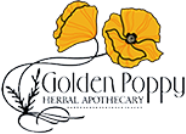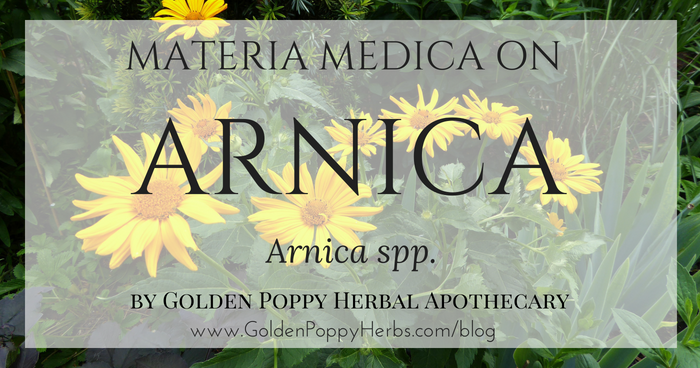
This bright yellow flower native to the alpine climate of the Rocky Mountains is a perfect symbol of warmer weather on its way. Also known as leopard’s bane and mountain tobacco, arinca is in the same family as the sunflower and has been used since the 1500’s for its healing roots and medicinal flowers. The most commonly known arnica is a species called Arnica Montana, this is what is typically used in homeopathic preparations found in stores. This type of arnica can easily be found in the mountains of Colorado, however there are several other varieties of arnica that are just as potent. One of the other commonly found varieties in our area is
Arnica Cordifiolia, or Heart Leaf Arnica.
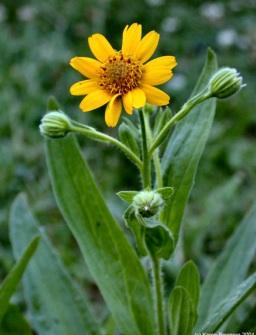
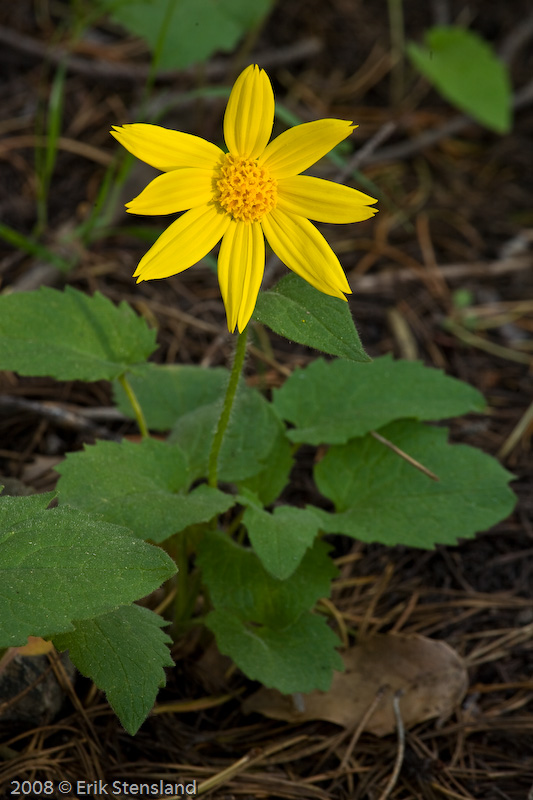 Notice the difference in the leaves? Which one is which do you think?
Notice the difference in the leaves? Which one is which do you think? Now, to the unexperienced, these two plants may look completely different, which is why knowing and understanding
botany to help you identify plants in the wild is so important, becuase you wouldn't want to go using the wrong plant now would you... Arnica is used topically for a wide range of conditions, including bruises, sprains, muscle aches, wound healing, superficial phlebitis, joint pain, inflammation from insect bites, and swelling from broken bones. More recent studies suggest it may also be helpful in the treatment of burns—making it the perfect summer companion. It's main action comes from it's blood moving properties, helping to break up congested blood and bring fresh blood into an affected area, which is exactly what you are looking for when you have any type of musclaur injury or bruise.
This plant is truly a must-have for anyone who enjoys physical activity. Arnica is planted in early spring and harvested throughout the summer and fall.
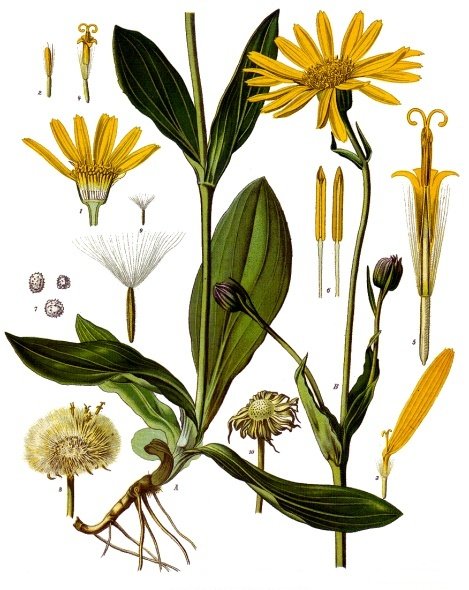
http://en.wikipedia.org/wiki/File:Arnica_montana_-_Köhler–s_Medizinal-Pflanzen-015.jpg
MATERIA MEDICA: ARNICA
Latin Name: Arnica montana L., A. chamissonis, A. cordifolia Parts Used: Fresh or dried flowers and leaves. The root is also used in European herbal preparations.
Typical Preparations:
FOR EXTERNAL USE ONLY UNLESS IN HOMEOPATHIC PREPARATIONS
- Infusion - approximately 1 teaspoon dried herb or 1 tablespoon fresh herb in 1/2 cup water, great as a topical wash or compress
- Tincture/Linament - excellent to use topically as it is easy to carry around and the alcohol allows it to penetrate into the deeper tissue layers (This is one of the many ingredient's in our Backpacker's Herbal First Aid Kit)
- Oil - 1 part dried herb in 5 parts oil - great for massage or for putting in an ointment or salve to carry while outdoors (Arnica infused oil is a crucial ingredient in our Sore Muscle Massage Oil...one of our most popular products)
- Homeopathics - use as directed on the bottle, this is the only way arnica can be used internally, it is excellent at helping to speed recovery and healing of injuries such as bumps, bruises, sprains, and strains.
Actions : Anti-inflammatory, vulnerary, blood moving
Uses:
- Anti-inflammatory
- Contusion injuries
- Bruises
- Aches
- Pains
- Sore muscles after exercise
- Swelling
Contradictions:
Use externally only. If you take any medicines regularly, discuss them with your doctor before you start using arnica supplements. They could interact with drugs like painkillers, steroids, blood pressure drugs, blood thinners, and herbs like ginkgo biloba, garlic, and saw palmetto.
Sources
- Medicinal Plants of the Pacific West by Michael Moore
- http://www.ncbi.nlm.nih.gov/pubmed/20412090
- "Arnica in Flora of North America". Efloras.org. Retrieved 2009-12-22. Jump up ^ Deliu, C. (September 2001 pages=581–585 publisher=Society for In Vitro Biology). "Clonal propagation of Arnica montana L., a medicinal plant". In Vitro Cellular and Development Biology - Plant 37 (5).
- Jenna Sumara (2006). "Arnica: the natural alternative for treating sore muscles". The Final Sprint. Retrieved 2008-12-11.
 This bright yellow flower native to the alpine climate of the Rocky Mountains is a perfect symbol of warmer weather on its way. Also known as leopard’s bane and mountain tobacco, arinca is in the same family as the sunflower and has been used since the 1500’s for its healing roots and medicinal flowers. The most commonly known arnica is a species called Arnica Montana, this is what is typically used in homeopathic preparations found in stores. This type of arnica can easily be found in the mountains of Colorado, however there are several other varieties of arnica that are just as potent. One of the other commonly found varieties in our area is Arnica Cordifiolia, or Heart Leaf Arnica.
This bright yellow flower native to the alpine climate of the Rocky Mountains is a perfect symbol of warmer weather on its way. Also known as leopard’s bane and mountain tobacco, arinca is in the same family as the sunflower and has been used since the 1500’s for its healing roots and medicinal flowers. The most commonly known arnica is a species called Arnica Montana, this is what is typically used in homeopathic preparations found in stores. This type of arnica can easily be found in the mountains of Colorado, however there are several other varieties of arnica that are just as potent. One of the other commonly found varieties in our area is Arnica Cordifiolia, or Heart Leaf Arnica. 
 Notice the difference in the leaves? Which one is which do you think? Now, to the unexperienced, these two plants may look completely different, which is why knowing and understanding botany to help you identify plants in the wild is so important, becuase you wouldn't want to go using the wrong plant now would you... Arnica is used topically for a wide range of conditions, including bruises, sprains, muscle aches, wound healing, superficial phlebitis, joint pain, inflammation from insect bites, and swelling from broken bones. More recent studies suggest it may also be helpful in the treatment of burns—making it the perfect summer companion. It's main action comes from it's blood moving properties, helping to break up congested blood and bring fresh blood into an affected area, which is exactly what you are looking for when you have any type of musclaur injury or bruise. This plant is truly a must-have for anyone who enjoys physical activity. Arnica is planted in early spring and harvested throughout the summer and fall.
Notice the difference in the leaves? Which one is which do you think? Now, to the unexperienced, these two plants may look completely different, which is why knowing and understanding botany to help you identify plants in the wild is so important, becuase you wouldn't want to go using the wrong plant now would you... Arnica is used topically for a wide range of conditions, including bruises, sprains, muscle aches, wound healing, superficial phlebitis, joint pain, inflammation from insect bites, and swelling from broken bones. More recent studies suggest it may also be helpful in the treatment of burns—making it the perfect summer companion. It's main action comes from it's blood moving properties, helping to break up congested blood and bring fresh blood into an affected area, which is exactly what you are looking for when you have any type of musclaur injury or bruise. This plant is truly a must-have for anyone who enjoys physical activity. Arnica is planted in early spring and harvested throughout the summer and fall.  http://en.wikipedia.org/wiki/File:Arnica_montana_-_Köhler–s_Medizinal-Pflanzen-015.jpg
http://en.wikipedia.org/wiki/File:Arnica_montana_-_Köhler–s_Medizinal-Pflanzen-015.jpg
